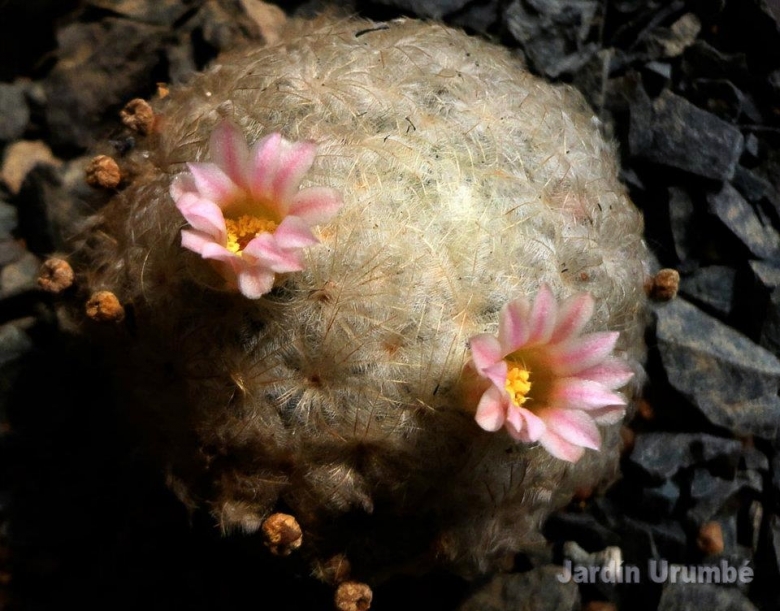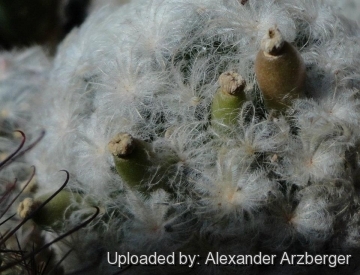Accepted Scientific Name: Mammillaria plumosa F.A.C.Weber in Bois
Dict. Hort. [Bois] 2: 804. 1898 Bois

Mammillaria plumosa var. roseiflora Photo by: Alexander Arzberger
Origin and Habitat: Garden origin. The natural species comes from the states of Coahuila and Nuevo León in Mexico.
Synonyms:
See all synonyms of Mammillaria plumosa
back
Accepted name in llifle Database:Mammillaria plumosa F.A.C.Weber in BoisDict. Hort. [Bois] 2: 804. 1898Synonymy: 6
back
Description: Mammillaria plumosa var. roseifloraSN|33266]]SN|33266]] is a selected form or cultivars with pink flowers instead of yellowish white. All the other characteristics namely stems size and form, spines, fruits etc. are identical to the standard species.
Habit: It is a clumping plants that forms low, dense mounds sometime up to 40 cm wide entirely covered by the mass of white feathery spines.
Stems: Depressed globose or somewhat elongate, without latex, spherical, 4- 7 cm high and in diameter. Light green, but appearing white because of the dense spines.
Tubercles: Small, flattened, 2-4 mm long, somewhat woolly in their axil.
Radial spines: About 40 per areole 1 - 7 mm long, white, weak, interlacing, feathery. The spines in this specie have very long hairs along the spine-axis arranged as are the segments of a bird's feather and that furnish an epidermal protection against the blasting sun of the desert.
Central spines: Absent.
Flowers: Up to 3-15 mm long sweetly scented. Perianth segment white or pale pink with a purplish-pink line running down to the centre.
Seeds: Black.
Subspecies, varieties, forms and cultivars of plants belonging to the Mammillaria plumosa group
Bibliography: Major references and further lectures
1) Edward Anderson “The Cactus family” Timber Press, Incorporated, 2001
2) James Cullen, Sabina G. Knees, H. Suzanne Cubey "The European Garden Flora Flowering Plants: A Manual for the Identification of Plants Cultivated in Europe, Both Out-of-Doors and Under Glass" Cambridge University Press, 11/Aug/2011
3) David R Hunt; Nigel P Taylor; Graham Charles; International Cactaceae Systematics Group. "The New Cactus Lexicon" dh books, 2006
4) N. L. Britton, J. N. Rose “The Cactaceae. Descriptions and Illustrations of Plants of the Cactus Family.” Volume 4, The Carnegie Institution of Washington, Washington 1923
5) Fitz Maurice, B, Sotomayor, M., Fitz Maurice, W.A., Hernández, H.M. & Smith, M. 2013. Mammillaria plumosa. The "IUCN Red List of Threatened Species." Version 2014.1. <www.iucnredlist.org>. Downloaded on 21 July 2014.
 Mammillaria plumosa var. roseiflora Photo by: Alexander Arzberger
Mammillaria plumosa var. roseiflora Photo by: Alexander Arzberger Mammillaria plumosa var. roseiflora Photo by: Alexander Arzberger
Mammillaria plumosa var. roseiflora Photo by: Alexander ArzbergerCultivation and Propagation: Needs regular water in summer, but for best appearance keep water off of the spines. Do not let the soil become too dry in winter, either. It does better with a good drained soil mix since it is a rot prone species, whose roots are easily lost in pots that stay damp for any length of time. It takes a couple of years to offset, but once it starts it can fill a 25cm pot in just a few years. Needs full sun or light shade in summer.
Propagation: Seeds, offsets (Cuttings root quickly).












